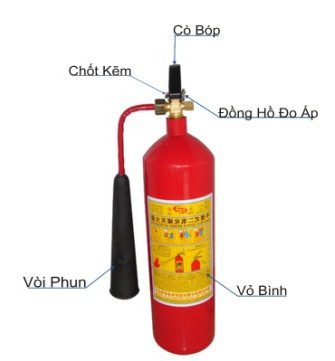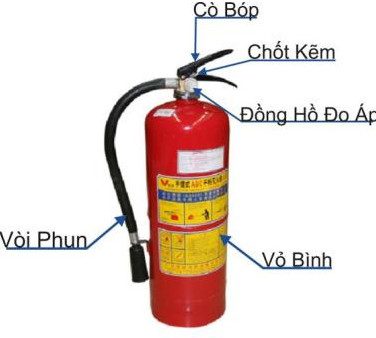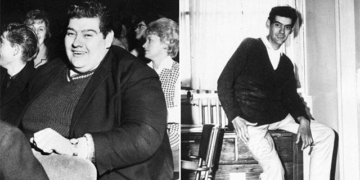We would like to guide you on how to use powder fire extinguishers and CO2 fire extinguishers in a comprehensive, detailed, and safe manner through the article below.
1. CO2 Fire Extinguishers: MT3 (3kg CO2) – MT5 (5kg CO2)….
a) Structure

Structure of a CO2 fire extinguisher.
b) Function
– The CO2 fire extinguisher is a portable fire extinguisher containing CO2 gas at -790C, which is compressed under high pressure. It is used to extinguish newly developed small fires: solid, liquid fires, and is particularly effective against electrical equipment fires and fires in enclosed spaces. Its usage is simple, convenient, and efficient.
c) How to Use and Fire Extinguishing Principle
When a fire occurs, grab the CO2 extinguisher and approach the fire. One hand should hold the nozzle directed at the base of the fire from a minimum distance of 0.5m, while the other hand opens the valve. Upon opening the valve, due to the pressure difference, the liquid CO2 in the extinguisher escapes through the dip tube and nozzle, transforming into a snow-like gas at -790C. When sprayed onto the fire, CO2 dilutes the concentration of the combustible gas mixture and simultaneously cools the burning area, leading to the extinguishment of the fire.
Note:
- Read the instructions carefully and understand the functions of each type of extinguisher to appropriately tackle different fire scenarios.
- Ensure to stop spraying completely before ceasing operation.
- When extinguishing liquid fires, spray over the surface of the burning liquid, avoiding direct spraying into the liquid.
- Choose the appropriate position and distance to spray based on the type of fire.
- Avoid using the extinguisher for outdoor fires. If used, choose the wind direction wisely.
- Be cautious of cold burns. Only hold the plastic or rubber parts of the nozzle and handle.
- Before spraying in enclosed spaces, ensure everyone is evacuated and plan an escape route after spraying.
d) Important Points When Using and Storing CO2 Extinguishers
- Do not use CO2 extinguishers on fires involving alkali metals, alkaline earth metals, charcoal, or fertilizers. Spraying CO2 on such fires can cause chemical reactions, producing carbon monoxide, a toxic and flammable gas that complicates the fire situation.
CO2 + C = 2CO; CO2 + M = MO + CO
- When spraying, hold the plastic part of the nozzle, avoiding the metal parts. Do not allow CO2 to spray on yourself as it can cause cold burns. Avoid using CO2 extinguishers for fires in open, windy areas due to low effectiveness.
- When extinguishing fires involving high-voltage electrical equipment, wear boots and insulated gloves; ensure safety precautions when extinguishing fires in enclosed spaces.
- Store extinguishers in a cool, visible, and accessible place for easy use. Do not place extinguishers in areas with temperatures exceeding 550C, as this may lead to pressure build-up and potential explosion if the safety valve fails.
- Regularly check, maintain, and replace any damaged components of the extinguisher: nozzle, hose, and valve. Replace any extinguishers that are leaking gas.
- To check the amount of CO2 in the extinguisher, the most common method is weighing it. If the CO2 weight decreases compared to the initial weight, the extinguisher is leaking.
2. Powder Fire Extinguishers
a) Structure

Structure of a powder fire extinguisher.
b) Function
Powder fire extinguishers contain nitrogen (N2) gas as a propellant to spray powder to extinguish fires. Depending on the type of extinguisher, they can effectively extinguish solid, liquid, gas fires, electrical fires, and newly developed equipment fires. The extinguishing powder is non-toxic, non-conductive, highly effective; the operation of the extinguisher is simple and easy to inspect, making it suitable for extinguishing small, newly developed fires.
The letters A, B, C on the extinguisher indicate its capability to extinguish different types of fires:
- A: For extinguishing solid fires such as wood, cotton, fabric, fibers…
- B: For extinguishing liquid fires such as gasoline, alcohol, solvents…
- C: For extinguishing gas fires such as LPG (liquefied petroleum gas)…
The numbers 2, 4, 8 represent the weight of powder contained in the extinguisher, measured in kilograms.
For example, an extinguisher labeled MFZ8 with ABC indicates it can be used to extinguish most solid, liquid, and flammable gas fires…
c) How to Use
* For Handheld Models: When a fire occurs, carry the extinguisher close to the fire location. Shake the extinguisher 3-4 times to loosen the powder, pull the safety pin, and aim the nozzle at the base of the fire, ensuring to face the wind. Hold the extinguisher at a distance of about 1.5m depending on the model, squeeze the nozzle to release the extinguishing powder. When the discharge weakens, move closer and sweep the nozzle back and forth to fully extinguish the fire.
* For Trolley Models:
- Push the trolley to the fire location, pull the hose to release the powder, and direct the spray at the base of the fire.
- Pull the safety pin, keeping the nozzle perpendicular to the ground.
- Firmly hold the nozzle, aim into the wind, and squeeze the trigger to spray the powder.
When opening the valve (the method varies based on the type of valve), the dry powder in the extinguisher is expelled by the pressure of the compressed gas (directly compressed with the powder or stored separately) through the hose system. When sprayed onto the fire, the powder inhibits the combustion reaction and isolates the combustible material from oxygen in the air, effectively extinguishing the fire.
Note:
- Read the instructions carefully and understand the functions of each type of extinguisher to properly position them.
- When spraying, position yourself at the wind’s direction (for outdoor fires); stand near an exit (for indoor fires). Ensure to stop spraying completely before ceasing operation.
- When extinguishing liquid fires, spray the extinguishing agent over the surface of the burning liquid, avoiding direct spraying into the liquid to prevent splashing and worsening the fire.
- Select the appropriate position and distance for spraying based on the type of fire and the remaining gas pressure in the extinguisher.
- Used extinguishers should be kept separate to avoid confusion.
- Keep the extinguisher in an upright position while spraying.
d) Important Points When Using and Storing Powder Fire Extinguishers
- Store in a visible, easily accessible location for fire emergencies.
- Place in a dry, well-ventilated area, avoiding direct sunlight and high thermal radiation, with a maximum temperature of 50°C. If kept outside, a shelter is necessary.
- Handle with care while moving. Avoid direct exposure to high temperatures and vibrating equipment.
- Regularly inspect the extinguisher according to the manufacturer’s guidelines or at least once every three months. If the gauge reads below the red line, recharge the gas.
- Check the propellant gas through the pressure gauge or by weighing and comparing with the initial weight. Check the powder weight by weighing and comparing.
- Regularly check, maintain, and replace any damaged components of the extinguisher: nozzle, hose, and valve. Replace any extinguishers that are leaking gas.


















































